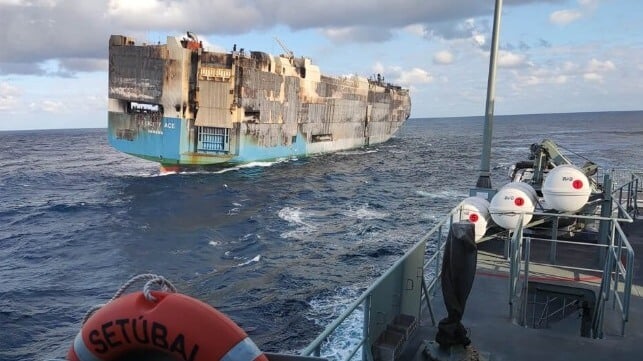IUMI: EV Fires Can Cause Explosions on Ro/Ros

The International Union of Marine Insurers has updated its guidance to warn that PCTC and ropax operators run a risk of explosion during an onboard EV fire, a previously underexamined problem.
Electric vehicle fires have been a major source of concern for ro/ro operators for years, and several operators have banned them from carriage. EV battery packs can self-ignite if cells overheat or develop internal faults; they can also catch fire from a nearby heat source, like a burning conventional vehicle. Once EV batteries enter thermal runaway, they burn at high temperature and are difficult to permanently extinguish. They also emit large quantities of toxic, flammable fumes, making hand-to-hand firefighting with a hose team even more challenging in the tight spaces of a full ro/ro deck.
The industry has adapted its firefighting practices to account for the realities of EV blazes, and operators now favor shutting off ventilation and flooding the affected hold with the fixed CO2 system. This is IUMI's recommendation as well, and the organization recommends that "fixed firefighting systems should be applied early, correctly and safely first rather than manual firefighting." The "early" component of this advice is essential, IUMI says, because waiting could allow the blaze to grow to the point that the fixed system gets disabled by the fire or gets overwhelmed, with potentially catastrophic consequences.
But this comes with its own risk, according to IUMI. At the right concentrations, the gases that are emitted from an EV battery pack are potentially explosive in combination with ambient atmosphere. Research suggests that the gas mix from an EV fire includes 30 percent hydrogen, which has high explosion potential. If these gases accumulate in an enclosed space without burning off, and mix with air in the right percentage, a blast could occur. Since the traditional fixed firefighting sequence starts with a full ventilation shutdown, before any CO2 is introduced, any gases from the fire would be trapped inside with air only for a period.
"A comprehensive firefighting strategy must not only consider the firefighting itself but also the management of potentially explosive gases that may accumulate during such incidents. The aim must be to integrate both aspects, firefighting and ventilation operation, without limiting the effectiveness of the overall firefighting system," IUMI cautioned. "Careful consideration should be given by shipowners to appropriate ventilation procedures for the extinguishing system installed and the vessel concerned."
Modern PCTCs have another hazard that inverts typical thinking on marine firefighting. With their wide-open deck layouts, newer PCTCs have no partitions from the starboard bulkhead all the way across to the port side. In addition to the implications for ease of spreading fire, the design creates unique stability considerations. Getting the deck wet - even a little bit - can reduce the friction between car tires and deck surface enough that it creates the risk of a catastrophic cargo shift from one side to the other. If the lashings aren't enough to hold the vehicles in place, the PCTIC could take on a heavy list, with potentially serious consequences. This means that by and large, hose teams for boundary cooling are a restricted option on a PCTC. "Only in calm weather (without swell and wind waves) locally applied small amounts of water can be recommended" for boundary cooling on a PCTC deck, IUMI recommends.
